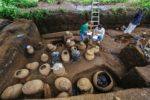 A few days ago, workers with Nicaragua’s National Electric Transmission Company (Enatrel) discovered six large pottery vessels while digging a ditch for a substation to power the new National Baseball Stadium currently under construction in Managua. They called in experts from the archaeological department of the Nicaraguan Institute of Culture (INC) who excavated the site further and discovered more than 30 of those large vessels. They also found the vestiges of inhumation burials, skeletal human remains and smaller pieces of pottery. Archaeologists believe this was a Pre-Columbian cemetery dating to sometime between 800 and 1350 A.D., although those dates have yet to be confirmed.
A few days ago, workers with Nicaragua’s National Electric Transmission Company (Enatrel) discovered six large pottery vessels while digging a ditch for a substation to power the new National Baseball Stadium currently under construction in Managua. They called in experts from the archaeological department of the Nicaraguan Institute of Culture (INC) who excavated the site further and discovered more than 30 of those large vessels. They also found the vestiges of inhumation burials, skeletal human remains and smaller pieces of pottery. Archaeologists believe this was a Pre-Columbian cemetery dating to sometime between 800 and 1350 A.D., although those dates have yet to be confirmed.
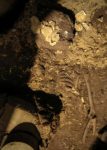 The skeletal remains are few and scattered. One of the most intact skeletons has a skull with some teeth still in the jaw (important features if there’s any hope of stable isotope analysis or DNA extraction), ribs, arm and leg bones. Its hand and feet, however, are missing.
The skeletal remains are few and scattered. One of the most intact skeletons has a skull with some teeth still in the jaw (important features if there’s any hope of stable isotope analysis or DNA extraction), ribs, arm and leg bones. Its hand and feet, however, are missing.
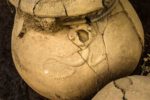 Some of the large pottery vessels contain human remains as well, and while their contents haven’t been thoroughly examined in situ, these were almost certainly Pre-Columbian funerary urns. Even though they were found buried less than three feet under the surface, many of them are in excellent condition, complete with fitted lids, reliefs and engraved images of animals like iguanas and human faces. Some even have traces of the original polychrome paint. They come in a variety of shapes — squashed spheres, pot-bellied, horizontal alien egg with the lid all the way to one side.
Some of the large pottery vessels contain human remains as well, and while their contents haven’t been thoroughly examined in situ, these were almost certainly Pre-Columbian funerary urns. Even though they were found buried less than three feet under the surface, many of them are in excellent condition, complete with fitted lids, reliefs and engraved images of animals like iguanas and human faces. Some even have traces of the original polychrome paint. They come in a variety of shapes — squashed spheres, pot-bellied, horizontal alien egg with the lid all the way to one side.
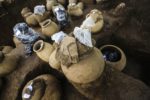 According to INC Director of Archeology Ivonne Miranda, this is a finding of national significance. It’s the first funerary complex found in Nicaragua with such a density of burials in the same small area. The ancient cemetery site hasn’t been populated in modern times, which is damn good luck because there’s no way these delicate remains and ceramics would have survived major construction just a few feet underground, but centuries ago the indigenous people who lived in what is now Managua settled there because of the ample sources of water from a nearby lake and rivers.
According to INC Director of Archeology Ivonne Miranda, this is a finding of national significance. It’s the first funerary complex found in Nicaragua with such a density of burials in the same small area. The ancient cemetery site hasn’t been populated in modern times, which is damn good luck because there’s no way these delicate remains and ceramics would have survived major construction just a few feet underground, but centuries ago the indigenous people who lived in what is now Managua settled there because of the ample sources of water from a nearby lake and rivers.
Other objects from the period have been found in Masaya and Granada, about 20 miles southeast of Managua, and in Rivas, about 56 miles south of the capital. Archaeologists hope this historic find will shed new light on the population and culture of the region.
“This allows us to understand a little better how the dispersion of these materials in the same space of time … and try to rescue the cultural identity of the old settlers of Managua,” Miranda said.
The archaeological discovery also “helps us to know about the behavior of our pre-Hispanic societies,” Miranda said.
Excavations are still ongoing. The urns, remains and other artifacts will be transferred to the National Palace of Culture where they will be analyzed in the National Museum’s laboratory.
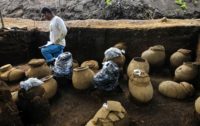
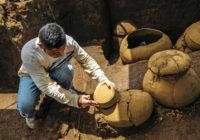
Is this true? We need more evidence please.